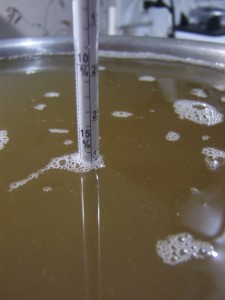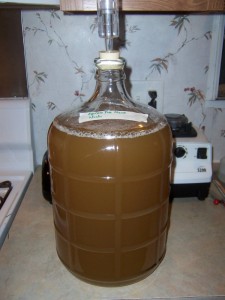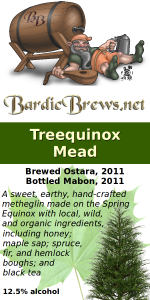It’s the First Day of Spring — Eostar, Ostara, the Vernal Equinox — in Maine, and I’ve been interacting with trees in my ecosystem as of late. They are like old friends that I haven’t seen in a few months. I wanted to honor this part of the seasonal cycle with my next batch of mead. We still have some snow on the ground, but it’s melting fast and there’s as much mud as snow. The trees are waking up, and I knew it was time to make a Treequinox Mead.
In northern New England, spring also means maple tapping season. It takes 40-60 gallons of sap, boiled down to reduce to 1 gallon of maple syrup. A friend was kind enough to bring me 4 gallons of maple sap the other day (thanks Jason!), and I knew I wanted to use it in a mead. Another friend, Arthur Haines, just posted a video about maple season:
Arthur is a botanist, and has written the best field book for my ecosystem that I’ve yet seen. He explains the process of getting maple sap skillfully and sustainably.
I used 2 gallons of the sap for the Treequinox Mead as a base, rather than the spring water I normally use. The other two are presently reducing into syrup on our stove.
I also had to cut down two trees in my yard for mushroom cultivation. We live on 2 acres of forest, and get little sunlight. We haven’t had much luck trying to grow vegetables, but I’m hoping that mushrooms will fare better. I wanted to use plug spawn, which requires fresh logs, so I knew I would have to take down a tree. I wanted to grow chicken of the woods (Laetiporus conifericola) and Phoenix Fir Oyster (Pleurotus pulmonarius), both of which grow on the Eastern Hemlock tree. Hemlocks are plentiful on our property, so it was easy to find one that was ready to be taken down. We also had to take down a fir tree to get the hemlock down safely. Both trees have been cut into 4′ logs (thanks again Jason!), which will rest for a month or so. Live trees contain anti-fungal compounds that dissipate a few weeks after the tree is cut. Both mushrooms grow on both hemlock and fir, so I’ll plug some of each species of mushroom into both species of log.
This also meant I had an abundance of both hemlock and fir boughs, that are now going to dry out and decay. I wanted to use as much of the tree as possible, so I gathered about a gallon of the boughs, along with some additional spruce in my yard, and made a Fir, Hemlock, and Spruce tea in the maple sap. I rinsed the leaves and then decocted them for 15 minutes in 2+ gallons of maple sap, removed the heat and put the pot on the back porch to cool off.
Once the tea had cooled to blood temperature, I brought it in and strained it. It tasted delicious! The sap is already sweet and the evergreen flavor was really good. I then added about 3/4 of a gallon of honey, adjusting the amount until I got an alcohol potential reading of 17.5%:
The conifer leaves have some citric acid in them, but I did make 3 cups of organic black tea for the tannins. I then pitched the yeast as normal, and am left with a beautiful 3 gallon batch of Treequinox Mead:
Don’t worry, Spruce Mead fans, I still plan on making another batch of Spruce Mead this year….
UPDATE: I just racked this mead and it’s delicious! Very similar to the Spruce Mead I made last year, but not as cloyingly sweet. It is still quite sweet though, at 5% remaining alcohol potential, meaning this batch is 12.5% alcohol. This mead is already starting to clear, unlike the Spruce Mead from last year which is still not clear!
UPDATE: I haven’t been posting labels much recently (since they are all variations on the same theme), but this one turned out especially cool I thought, with the maple leaf in the background and the hemlock tree in the corner:



